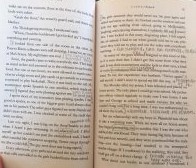Annotation Strategies
STRATEGY 1
What, when, _______ , why, and how?
Ask WH-questions as you preview the title, headings, and visuals. As you continue reading the page, write questions in the margins.
- Good readers are always wondering while they read.
-
Questioning helps YOU focus on what’s important in the text.
- If you are reading fiction, you might ask questions about what will happen next or why a character acted in a certain way.
- Use sticky notes (post-its) if the margins are too small for all your questions.

STRATEGY 2
Start by underlining or highlighting the new word. Note the words that you don’t know.
- Use context to guess the meaning. Write your guess in the margin or on a sticky note.
- Write simple definitions or synonyms in English in the margin.
- Keep a list of new words as part of your vocabulary-building practice. Create your own flash cards to remember new vocabulary.

STRATEGY 3
Make predictions and draw inferences. Take a guess about the content based on a title. Draw inferences based on the ideas that come to your mind while reading.
-
Inferring is how readers go beyond what is on the written page. This is a key part of critical thinking!
-
Making an inference will help you build deeper meaning. Write your predictions and inferences in the margin or on a sticky note.

STRATEGY 4
Activate schema: Draw connections from what you are reading to your own experience.
Schema is all of your relevant prior knowledge which helps you relate to the story (in fiction) or the topic (in nonfiction).
- We can draw connections to ourselves, another text, or the experiences of others.
- Write your connections in the margin or on a sticky note and share with a classmate.
STRATEGY 5
- Write a question mark (?) in the margin.
- Continue reading the page. Then return to the passage that was unclear. Write a question in the margin or on a sticky note.
-
You may find that further reading brings clarity. If it does not, re-read the difficult section and determine what you need to do to better understand the reading.
- Ask a classmate for their ideas. Raise your hand and ask your teacher for help. Collaboration is the solution!
STRATEGY 6
Summarize and synthesize: demonstrate your critical thinking skills.
Put the author’s ideas into your own words. Link the ideas to other readings.
- Close the book and jot down the main ideas that you remember. (You can pull all of the sticky notes out of your book and use them to write the main ideas.)
- Check your main ideas with a classmate. Edit as necessary. Be sure to include the author’s name as part of the summary.
- Tell your classmate how the main points of this author connect to another reading (= synthesis).
- After sharing information, write down another sentence or two. Explain how these ideas are linked.
- See example in Appendix D.
